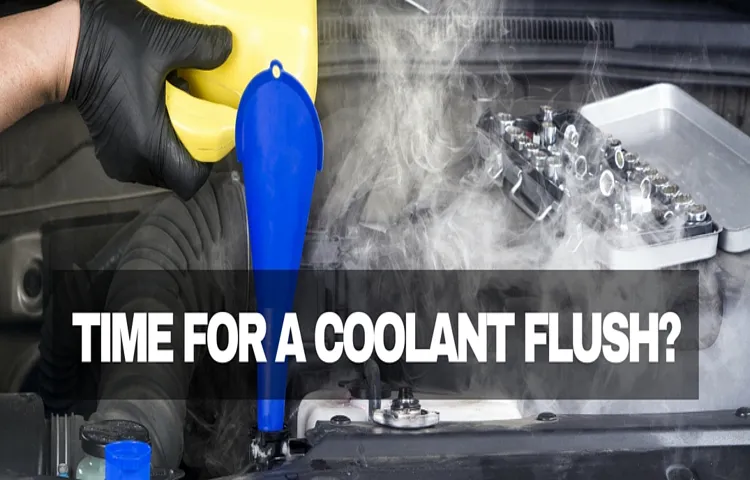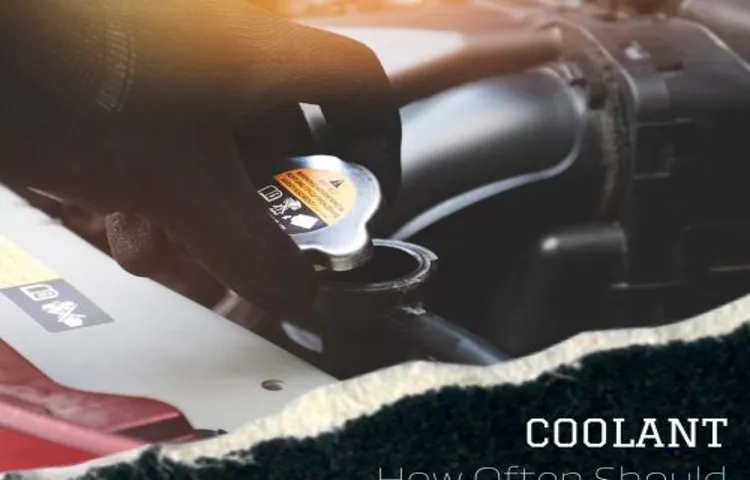Coolant flushes are an essential part of maintaining your car’s engine health. As a car owner, it’s crucial to understand how often you should do a coolant flush to keep your engine functioning smoothly. After all, your engine’s life expectancy depends on how well you take care of it.
Neglecting proper maintenance procedures, such as coolant flushes, can lead to serious problems, including engine failure. So, how often should you do a coolant flush? Is it every year, two years, or three years? In this blog, we will dive into the factors that determine how often you should do a coolant flush and why it’s vital to do so. By the end of this post, you will have a better understanding of how coolant flushes work and how important they are for your car’s engine health.
What is a coolant flush?
If you’re wondering how often you should do a coolant flush, the answer depends on your car model and the type of coolant used. Typically, coolant flushes are recommended every 30,000 to 50,000 miles. However, your car’s owner’s manual may have specific recommendations based on its make and model.
The purpose of a coolant flush is to remove dirty and old coolant from your car’s engine block and radiator and replace it with fresh coolant. Carrying out this maintenance task will help to prevent any buildup of debris or sediment in the cooling system, which can cause overheating or damage to the engine. Additionally, flushing the coolant system will help to extend the life of your engine by preventing rust and corrosion.
Regularly performing coolant flushes will help to ensure that your car stays cool and reliable, giving you peace of mind on the road.
Explaining the purpose of a coolant flush
A coolant flush is a process of draining the old coolant from a vehicle’s cooling system and replacing it with fresh coolant. Cars and trucks rely on coolant to maintain an optimal operating temperature, which prevents the engine from overheating. Over time, coolant can break down and become contaminated with rust, dirt, and other debris, meaning it is no longer effective in its role.
A coolant flush is necessary to remove these impurities and ensure that the vehicle’s cooling system is running at maximum efficiency. It is recommended that a coolant flush is carried out every two to three years, depending on the manufacturer’s guidelines and the vehicle’s usage. Failure to perform a coolant flush can result in a range of issues, such as engine overheating, decreased fuel economy, and accelerated wear and tear on components within the cooling system.
Therefore, it is important to have a coolant flush performed to maintain the health of your vehicle’s engine and ensure it runs smoothly for years to come.

Importance of maintaining a cooling system
Maintaining the cooling system of your vehicle is vital to its longevity and performance. A coolant flush is an essential part of maintaining your cooling system. A coolant flush is the process of draining the old coolant from your car, cleaning the system with a cleaning solution, and refilling it with new coolant.
This process helps to remove any contaminants that may have built up in the system, which can cause leaks or corrosion. It also ensures that your engine stays cool and doesn’t overheat. Coolant flushes should be done every two years or 30,000 miles, whichever comes first.
Neglecting to do so can cause damage to your engine and lead to costly repairs. So, make sure to schedule a coolant flush at your local repair shop to keep your vehicle running smoothly for years to come.
Signs that you need a coolant flush
Wondering how often to do a coolant flush on your vehicle? It’s recommended that you have a coolant flush done every two years or 30,000 miles. But sometimes, signs may indicate that you need one sooner. If you notice that your engine temperature gauge is higher than usual, or if your heater isn’t producing enough heat, it could be a sign that your coolant is old and needs replacing.
Another sign is if the coolant appears dirty or rusty, indicating that it’s not doing its job of protecting your engine from corrosion and overheating. If you experience any of these symptoms, it’s best to bring your car to a trusted mechanic to check if a coolant flush is needed. Remember, having your coolant system maintained regularly can help extend the life of your vehicle and provide you with a smooth, worry-free driving experience.
How to test if your coolant needs to be replaced
If you are wondering whether it’s time to replace your car’s coolant, there are a few tell-tale signs you should keep an eye out for. One of the most noticeable signs is if your temperature gauge starts to rise above the normal range. If you notice this happening, it could be a sign that your coolant needs flushing.
Another indication is if you notice a sweet smell coming from your vehicle. This is usually a clear indication that the coolant is leaking and needs replacing. You may also notice that the coolant appears rusty or has turned a different color, which could be a sign that it has become contaminated.
If any of these symptoms arise, it’s important to get your coolant checked by a professional as soon as possible. Not replacing the coolant can cause your engine to overheat and lead to costly repairs down the line. So, don’t ignore the signs, and make sure to replace your coolant when necessary, to keep your car running smoothly and avoid any major headaches.
Factors that affect coolant life
Coolant flush, coolant life, signs of needing a coolant flushAs a car owner, it is essential to ensure that your vehicle’s engine stays cool and runs smoothly at all times. Your car’s coolant helps regulate its temperature and prevents overheating. However, your car’s coolant will not last forever and will need replacement every 30,000 to 50,000 miles.
Several factors can impact the lifespan of your vehicle’s coolant, including the type of coolant used and the frequency of use. Signs that you need a coolant flush include discoloration of the coolant, a sweet odor coming from your car’s exhaust, steam coming from the engine, and your car’s temperature gauge being at an abnormal level. A coolant flush will help extend the life of your car’s engine and prevent severe damages.
It is best to have your vehicle’s coolant flushed regularly to avoid costly repairs and extend the life of your engine. So, be sure to pay attention to these signs and bring your car to a trusted mechanic for a coolant flush.
How often should you do a coolant flush?
If you’re wondering how often you should do a coolant flush, the answer will vary depending on the car manufacturer’s recommendation and several other factors. Generally, most manufacturers recommend doing a coolant flush between every 30,000 and 60,000 miles or every five years, whichever comes first. However, if you live in an area with significant temperature fluctuations or frequently drive in harsh conditions, you may need to do it more frequently.
Coolant flushes are essential to maintain the engine’s temperature and prevent it from overheating, which can cause severe damage to the engine. Neglecting to flush the coolant system can lead to rust, corrosion, and debris buildup, compromising the engine’s integrity. Therefore, it’s crucial to adhere to the manufacturer’s recommended maintenance schedule and keep an eye on your vehicle’s performance.
Regular coolant flushes will save you money in the long run by extending the life of your engine and preventing costly repairs. So, make sure to consult your vehicle’s manual, and if you’re ever in doubt, bring it to a certified mechanic to ensure your car is running correctly.
Manufacturer recommendations for coolant flushes
Coolant flushes are an essential part of routine vehicle maintenance. Manufacturers typically recommend getting a coolant flush done every 30,000 to 50,000 miles, but this can vary depending on the make and model of the vehicle. It’s important to follow the manufacturer’s recommendations in order to prevent engine damage and overheating.
Neglecting to get a coolant flush can cause buildup of debris and contaminants that can clog the cooling system and lead to costly repairs. Additionally, flushing the coolant system can also help prevent rust and corrosion from damaging engine components. Overall, it’s important to schedule coolant flushes as recommended by the manufacturer to ensure that your engine stays in good shape and to avoid unnecessary repairs down the road.
Factors to consider when determining how often to flush your coolant
When it comes to maintaining your engine’s health, how often you should flush your coolant can depend on a few factors. The first is the type of coolant you’re using. If you’re using an organic acid technology (OAT) coolant, it can last up to 150,000 miles before needing a flush.
However, traditional coolants need to be flushed every two to three years or 30,000-50,000 miles. Another factor to consider is the type of driving you do. If you do a lot of stop-and-go driving or frequently drive in hot climates, you may need to flush your coolant more regularly.
Additionally, if you’ve experienced any overheating or other engine issues, it’s a good idea to schedule a coolant flush sooner rather than later. Remember, neglecting to flush your coolant can lead to engine damage and costly repairs, so be sure to follow your manufacturer’s recommendations and consult with a trusted mechanic if you’re unsure.
Conclusion and summary
In conclusion, the frequency at which you should flush your coolant depends on a number of factors including the age of your vehicle, your driving conditions, and the type of coolant you use. But as a general rule of thumb, it’s always better to err on the side of caution and flush your coolant every 30,000 miles or so. After all, when it comes to keeping your car running smoothly, a good flush is worth a thousand repairs.
So take care of your coolant, and your car will take care of you – even in the hottest of summers and the chilliest of winters. Cheers to a well-engineered cooling system and a happy engine!”
FAQs
Why is a coolant flush important?
A coolant flush helps to remove any impurities or debris that may have built up in the coolant system. It keeps the system running smoothy and prolongs the life of the engine.
How often should I do a coolant flush?
It is generally recommended to do a coolant flush every 2-5 years, depending on the make and model of your vehicle. Check your owner’s manual for manufacturer recommendations.
Can I do a coolant flush myself?
Yes, you can do a coolant flush yourself if you feel comfortable working on your vehicle. However, it is important to follow the proper procedures and use the correct type of coolant.
What are the signs that I need a coolant flush?
Some signs that you may need a coolant flush include overheating, strange smells, or a change in the color or consistency of the coolant.
Is a coolant flush expensive?
The cost of a coolant flush can vary depending on the make and model of your vehicle and where you have the service done. However, it is typically an affordable maintenance task.
What type of coolant should I use for a coolant flush?
It is important to use the type of coolant recommended by your vehicle’s manufacturer. Using the wrong type can cause damage to the system.
Can a coolant flush fix overheating issues?
While a coolant flush can help prevent overheating by keeping the system clean and functioning properly, it may not fix underlying issues such as a faulty thermostat or water pump. It is best to have a professional diagnose and repair any overheating issues.

